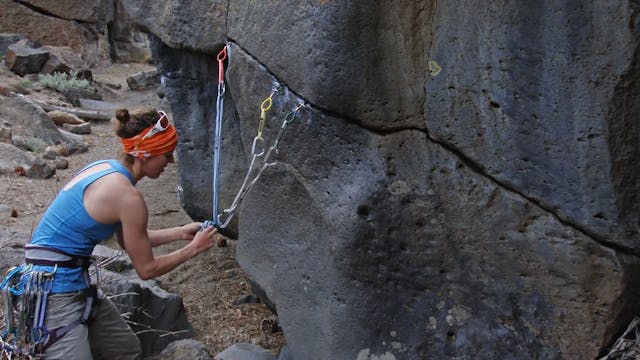Traditional Climbing: 15. Alternative Trad Anchor - Consideration #2
Traditional Climbing
•
1m 46s
In this video we look at another way to build a traditional anchor in the event the climber has made it to the top of the route, has three pieces of gear to place, but does not have a cordelette or sling.
Step 1: Place your three pieces of gear.
Step 2: Give yourself a couple arms’ lengths of slack and tie a clove hitch to the uppermost piece of gear.
Step 3: Take out another couple arms’ lengths of slack after tying the first clove hitch, and tie another clove hitch to the bottom anchor piece.
Step 4: Clip the length of rope between both clove hitches to the middle piece of gear, then pull down on the segments of rope between each protection point (similar to anchoring with a cordelette) and tie an overhand or figure 8 knot to create an equalized master point.
Step 5: To belay from this type of anchor, the climber can either perform a redirect belay (for more on this see our video on “How To Belay From Above”) or direct belay (for more on this see our video on “Direct Belay using an Auto-Block Device”) from the master point.
The belayer can also adjust their tether length by tying a clove hitch to the master point, similar to a standard cordelette anchor system.
We hope you found this video helpful. Feel free to comment below with questions or thoughts!
Please remember, climbing is inherently dangerous. Climb at your own risk.
Up Next in Traditional Climbing
-
Traditional Climbing: 16. Trad Anchor...
In this video we review considerations for building a traditional anchor with slings, in the case where a cordelette is not available. To do this you may need a mix of shoulder length slings and double length slings.
Step 1: Place three solid pieces of gear.
Step 2: Using a shoulder length ...
-
Traditional Climbing: 17. Combining O...
What happens when you are not convinced that three anchor pieces is enough to make a solid anchor? Maybe rock quality is marginal, the cracks are flared, or that stopper just doesn’t have good surface area contact with the rock.
In the video above, we highlight an example where two protection ...
-
Traditional Climbing: 18. Horizontal ...
In this video we review considerations for horizontal traditional anchors, where the anchor pieces are all placed in a horizontal crack as opposed to a vertical crack.
Some considerations when using horizontal trad anchors include:
1. Lifespan of gear - Sustained weight or tension on horizo...


